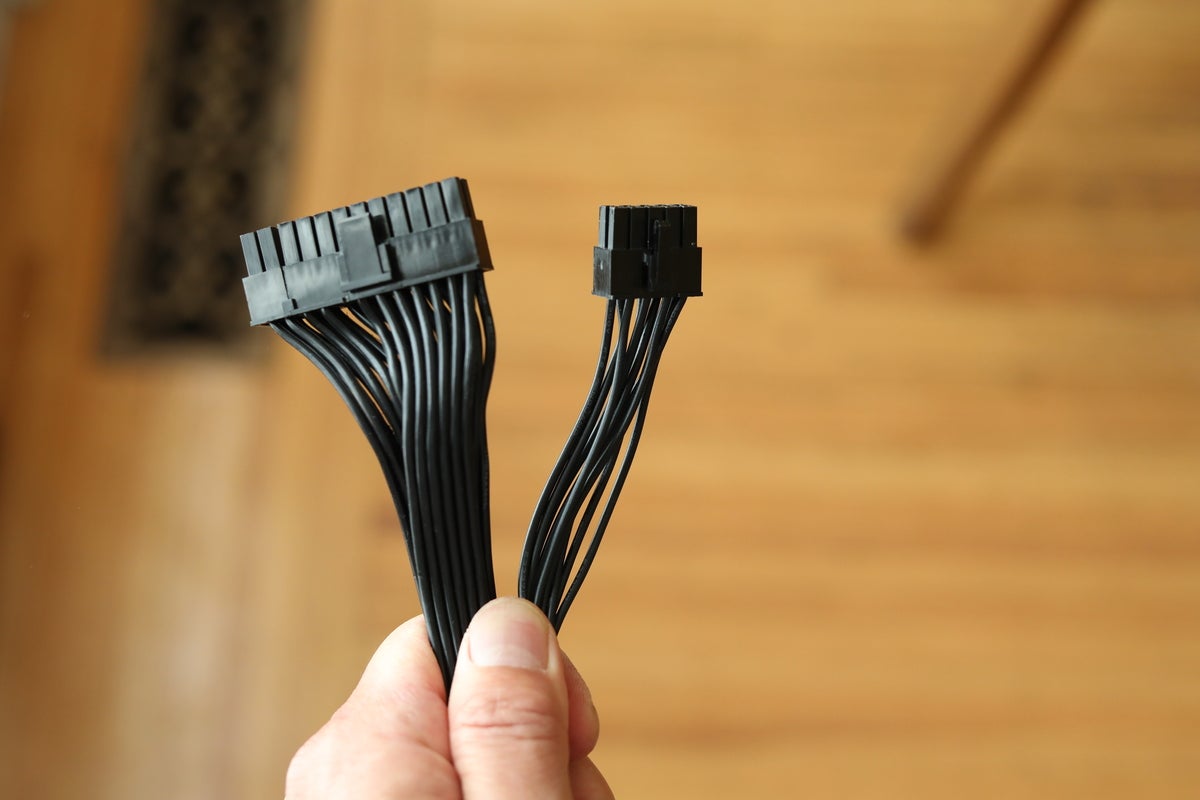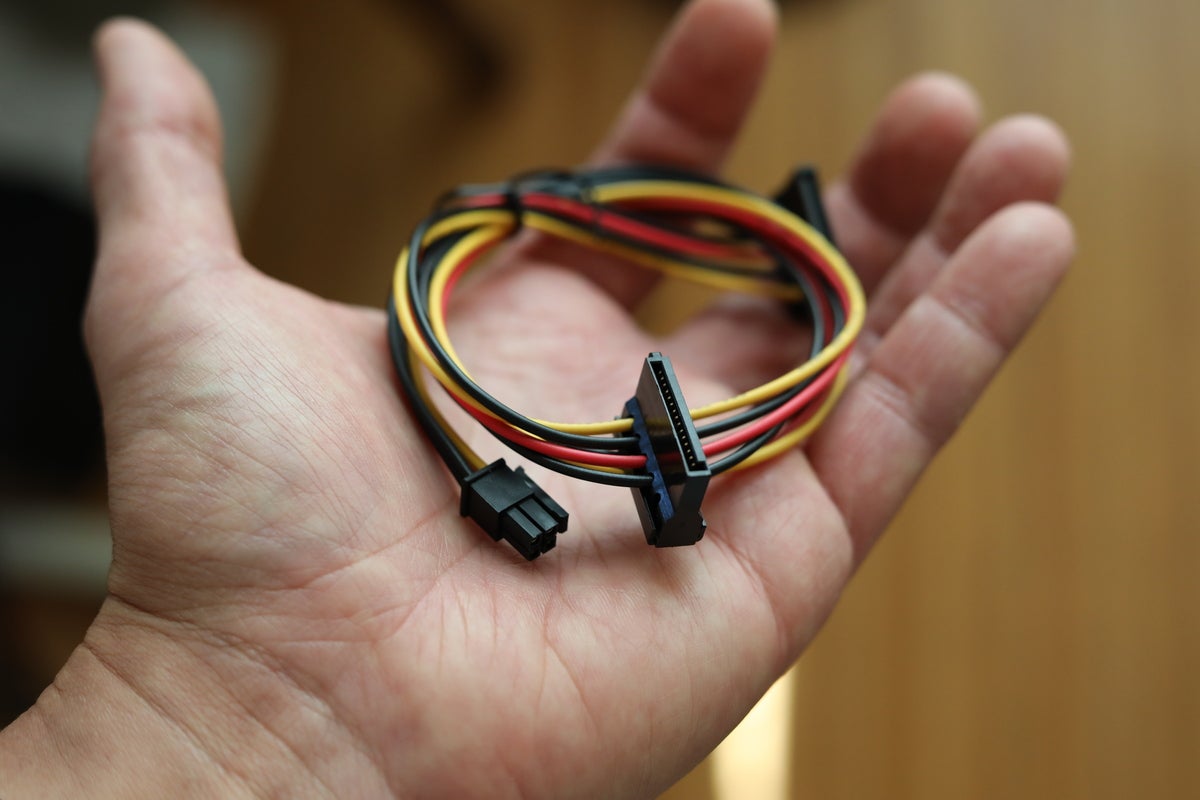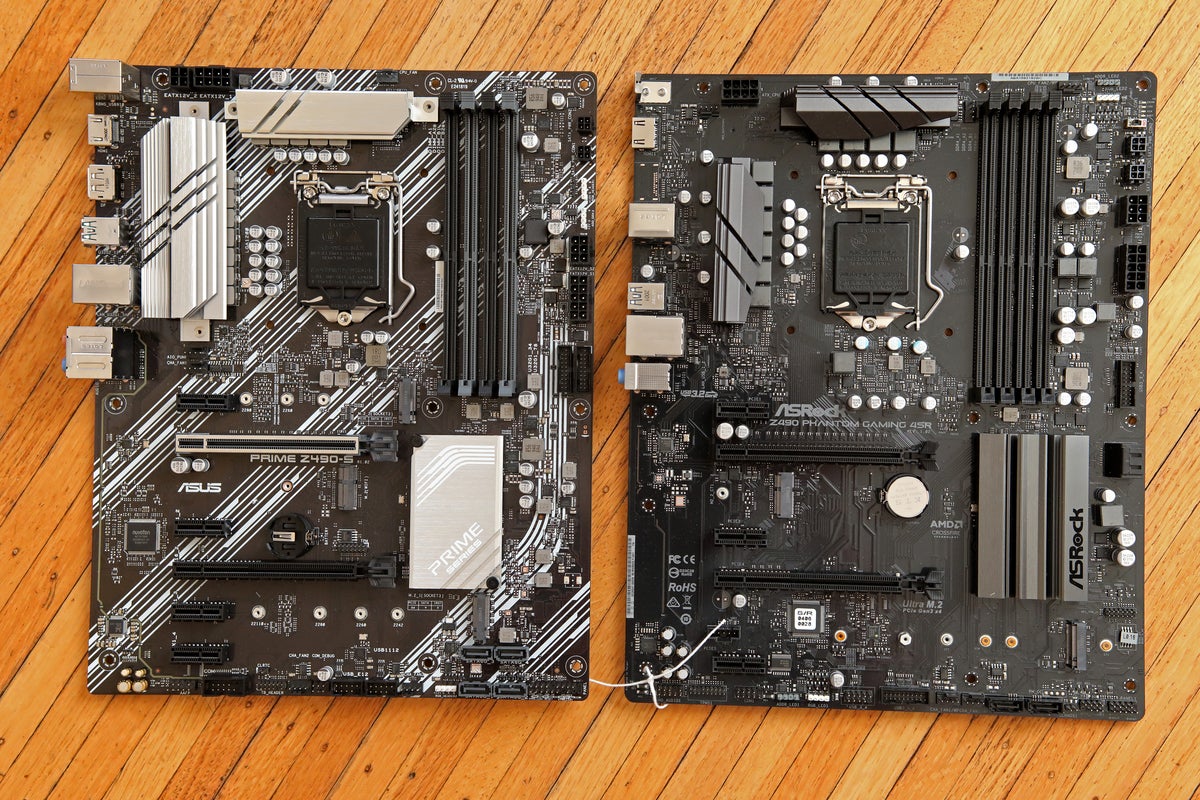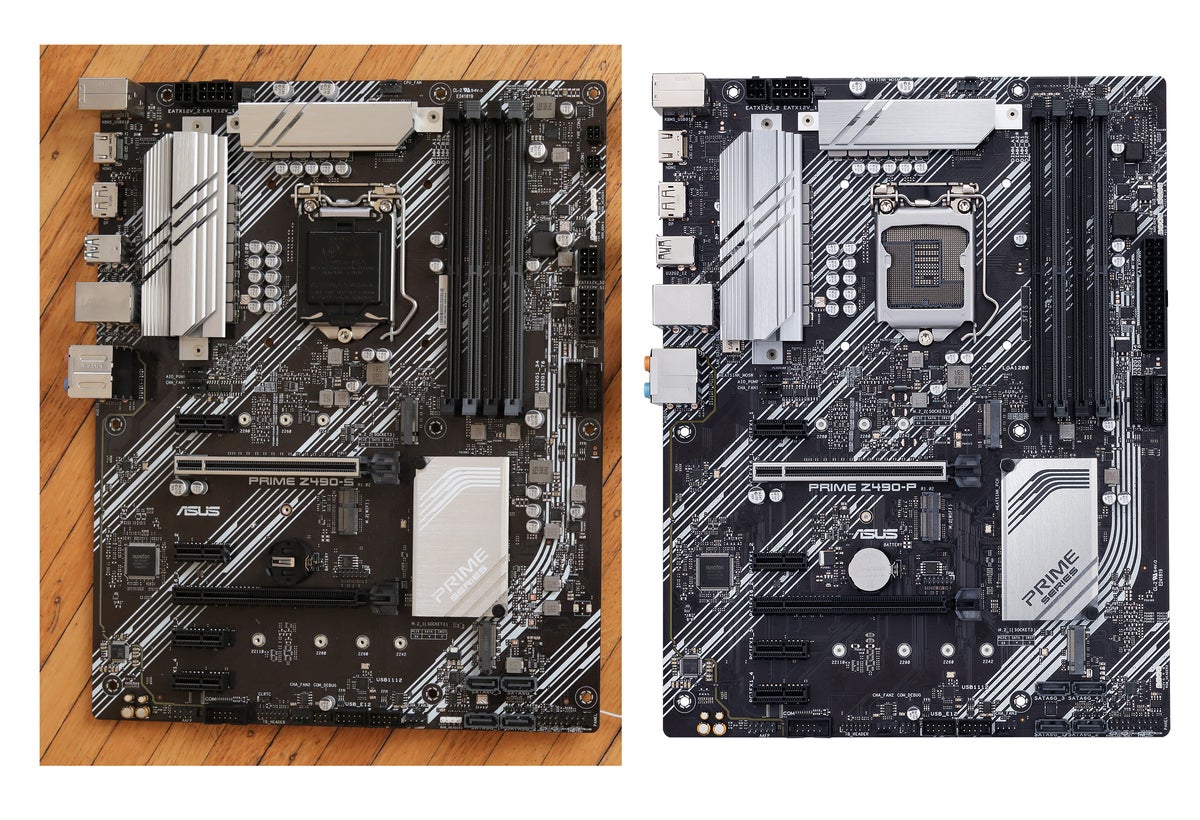 Credit: Gordon Mah Ung
Credit: Gordon Mah Ung
Intel’s latest power play isn’t about toppling AMD, but about energy efficiency. The company's new ATX12VO power supply standard is designed to help desktop PCs meet increasingly stringent government standards on idle power consumption.
ATX12VO does require a sacrifice. Newer power supplies will jettison support for old-school 3.3-volt and 5-volt rails, and concentrate solely on producing 12-volt power. But after kicking the tires on a pair of ATX12VO motherboards as well as an actual ATX12VO PSU, we can say that the future of desktop PC power looks brighter—and your old-friend legacy parts aren’t moving too far away.
ATX12VO will show up first in pre-built PCs from OEMs, but no one's ruling out an eventual jump to DIY parts. Let's take a closer look.
What makes ATX12VO power-efficient
ATX12VO's greater efficiency mainly comes from the removal of transformers and other PSU parts for those voltage “rails” that eat power during idle periods. Early results from Intel look impressive. If you look at the chart below, you can see the efficiency of a 500-watt ATX12VO 80 Plus Gold compared with a 500-watt multi-rail ATX 80 Plus Gold and 500-watt ATX Plus Bronze unit.
 Intel
Intel
ATX12VO focuses on squeezing out more efficiency from a PC at idle, which it largely appears to do.
As Intel points out: Even a pricier 80 Plus Gold PSU doesn’t gain much efficiency compared to a lower-cost 80 Plus Bronze PSU. The 80 Plus ATX12VO unit, however, is pretty spectacular at idle loads. With a 15-watt load on the DC side, the ATX12VO can achieve 78-percent efficiency, while the multi-rail power supplies are basically 59 percent. In actuality it probably doesn’t mean more than 5 or 7 watts, but because a lot of desktops idle far more than they are used heavily, it adds up to a lot of power saved over a year’s time.
Those two voltage “rails” don’t go away—they just move into a motherboard. Intel showed off a couple of pictures of a, ATX12VO board, but the difference hits home when you see an ATX12VO PSU next to a standard 24-pin Main Power Connector from a standard multi-rail ATX power supply.
 Gordon Mah Ung
Gordon Mah Ung
You can see the advantage of an ATX12VO 8-pin connector (right) next to a standard 24-pin ATX connector (left).
Quite a few of the extra pins and wires from the standard multi-rail ATX PSU are used for 3.3-volt and 5-volt power rails. By shedding these rails, the cable slims down significantly.
 Gordon Mah Ung
Gordon Mah Ung
Here’s a view of the top of the new ATX12VO’s 10-pin connector (right) next to a 24-pin ATX connector (left).
The simplification in connectors also means a lot fewer numbers on the PSU label. You can see that below with the impressively small SilverStone Strider SST-ST1200-PTS Platinum 1200-watt unit on the left, versus the High Power HP1-P650GD-F12S ATX12VO unit on the right.
The High Power has two simple numbers denoting 12-volt, and 12-volt standby power that’s used for the PC when it is asleep. If you look closer at the Strider you can see the 3.3-volt and 5-volt rails, minus-12-volt, and 5-volt standby power that gets thrown overboard with ATX12VO.
 Gordon Mah Ung
Gordon Mah Ung
A glimpse at the compact SilverStone ATX multi-rail PSU (left) is downright complicated next to the the new ATX12VO which carries numbers for 12 Volts Only (right.)
By eliminating the unused power rails you end up with fewer components, too. While the High Power 650-watt ATX12VO isn’t a high-end PSU like the SilverStone Strider, it did look pretty empty inside the High Power (below). A traditional PSU would typically have additional transformers and capacitors for the 3.3-volt and 5-volt power.
 Gordon Mah Ung
Gordon Mah Ung
The inside of a 650-watt High Power ATX12VO power supply is pretty empty, thanks to the lack of circuits for 3.3-volt and 5-volt rails.
The cabling is also fairly simple. Below is a picture of the ATX12VO with all of the connectors and cables. On this particular PSU you get the ATX12VO 10-pin Main Power Connector, two 4-pin CPU connectors, an 8-pin CPU connector, plus three 6-pin PCIe connectors. All of them, of course, are 12 volts only.
 Gordon Mah Ung
Gordon Mah Ung
ATX12VO PSU’s will feature far less cable bulk and apparently still the option to offer SATA power with only 12 volts.
ATX12VO does make some provisions for people who want to plug in extra hardware such as lights, fans, or sound cards so you can have standard 4-pin power Molex. While that Molex used to carry other voltages, the one in the ATX12VO can only carry 12 volts. If you’re powering up a fan or LED strip—it needs to run on 12 volts.
 Gordon Mah Ung
Gordon Mah Ung
We were surprised to find a SATA connector on the ATX12VO PSU (right). The lack of wires in the middle is where 5 volt power would be carried on a standard SATA connector (left).
One surprise was the SATA power connector. With ATX12VO, this is supposed to be moved off of the PSU, but High Power chose to include one on its ATX12VO PSU. One key difference you should note is the SATA power connector only carries 12 volts. You can see it in the picture above, where only the 12-volt wires are run to it. If your hard drive requires 5 volts to run the controller, this connector would not work for you. Instead, you’ll need an ATX12VO SATA connector cable like the one below.
 Gordon Mah Ung
Gordon Mah Ung
An ATX12VO cable would run directly to your motherboard and provide 5-volt and 12-volt to devices.
ATX12VO recommends that board makers support from four to eight SATA devices. For a four-SATA power connector configuration, two 3mm connectors would be used like the cable above to support four SATA devices. There’s also a slightly larger connector that features 6 pins and can power up to four SATA devices on the cable. Intel said in final production cables and probably most boards, you’ll probably get a single 6-pin SATA power connector or dual SATA power connector. It’s up to the motherboard vendor of course, but Intel anticipates more budget-friendly boards to need only four SATA power and data connections, so a single 6-pin connector saves on real-estate.
Intel said a slight change in how the connectors are keyed in final parts will allow a 4-pin connector to fit into a 6-pin connector, for those want a smaller wire harness.
 Gordon Man Ung
Gordon Man Ung
Rather than plug in to your PSU, you would power your SATA devices instead from your motherboard.
What ATX12VO motherboards will look like
ATX12VO motherboards themselves look, well, like ATX motherboards. We got to touch the Asus Prime Z490-S and the Asrock Z490 Phantom Gamer 4SSR. Both look like mid-range boards that don’t have all the bling of a high-end board—like most motherboards that you find in a pre-built or OEM PC. Because ATX12VO will be used in OEM and smaller system integrator PCs, it probably makes sense to see boards like this initially.
 Gordon Mah Ung
Gordon Mah Ung
The Asus Prime Z490-S (left) and Asrock Z490 Phantom Gamer 4SSR (right) both are built on the new ATX12VO spec.
To give you an idea of how much Asus cribbed from an existing Prime ATX board for its ATX12VO board, we compared the Asus Prime Z490-S to an image of the Asus Prime Z490-P. It’s pretty clear Asus made only a few visual alterations to make the ATX12VO version.
 IDG
IDG
The ATX12VO Asus Prime Z490-S (left) next to the ATX Asus Prime Z490-P (right.)
After seeing the Asrock Phantom Gamer 4SSR, we thought that the additional voltage regulation modules to the right of the RAM indicated that ATX12VO mandated considerably more hardware over a typical motherboard. But after examining the Asus Prime Z490-S, we came to the conclusion that moving the 3.3-volt and 5-volt rails to the motherboard doesn’t always take all that.
 Gordon Mah Ung
Gordon Mah Ung
A tighter shot of the Asus (left) and Asrock (right) SATA power sections.
You can see the Asus Prime laying on top of the Asrock Phantom Gamer. While there is a choke, capacitor and MOSFET on the Asus for the SATA power, it’s not really more than a comparable ATX motherboard from Asus.
Perhaps more telling is the ATX12VO Asus Prime Z490-S compared to the ATX Asus Prime Z490-P. Here are both boards up close, and zoomed in on the SATA power connectors. While there are alterations, it doesn’t look like a big deal. In fact, even looking at the Asrock Z490 Phantom Gaming 4SR that the ATXV12VO version is based on, it doesn’t look like a major change either.
 IDG
IDG
The ATX12VO board (bottom) compared to the ATX version (above.)
One thing we did notice on both ATX12VO boards was the inclusion of a 6-pin Extra Board Power connector near the 10-pin power connector. The Extra Board Power is additional 12-volt power which is decided on by the board maker. Intel said the Extra Board Power is there for users who decided to plug in additional PCIe cards or other power-heavy devices.
Better wiring
To give you an idea of how much wiring is saved, here’s a shot of a standard ATX motherboard with the 24-pin connector from the SilverStone plugged in.
 Gordon Mah Ung
Gordon Mah UngAnyone who has ever done a build knows how difficult it can be to wrangle the trunk of wires in a tight build. The 10-pin ATX12VO cable represents a major reduction in wiring that’s easy to shape and tuck to your heart’s content.
 Gordon Mah Ung
Gordon Mah Ung
An ATX12VO connector from a Corsair adapter cable plugged into an ATX12VO Asrock motherboard.
The cable above isn’t the one from the High Power ATX12VO power supply—it’s actually from a Corsair adapter cable. The cable is designed to let anyone with a fully modular Corsair PSU use it with an ATX12VO motherboard. The cable actually contains a circuit to provide 12-volt standby power to the ATX12VO motherboard.
 Gordon Mah Ung
Gordon Mah Ung
An adapter cable that could be used with a current Corsair modular PSU to power a newer ATX12VO board.
One problem with using your existing multi-rail PSU with a converter cable is you don’t gain the efficiencies of an actual ATX12VO PSU, as the 3.3-volt and 5-volt rails continue to eat energy at idle loads.
Intel’s rationale for offering these options is to make adoption of ATX12VO as painless as possible. A person could, for example, keep an existing multi-rail PSU but use an ATX12VO board, then at a later time buy a newer ATX12VO to take advantage of the efficiency gains.
Most of the spec, in fact, seems to be built that way. In the early spitballing, Intel thought about moving to 24-volt like laptops or even adopting different connectors, given that PCIe, and 4-pin and 8-pin connectors, are all basically repackaged 12 volts. In the end, Intel said it decided against any radical changes to make it as friendly as possible to adopt ATX12VO for everyone.
Right now, of course, the spec is mainly aimed at system vendors who have to meet the stricter government guidelines. But with what we’re seeing—it actually might be worth it for DIYers to switch over too.
 Gordon Mah Ung
Gordon Mah Ung
















